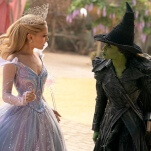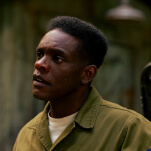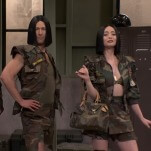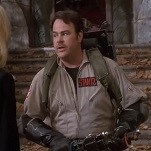I’m a sucker for a good time loop story. “Magic To Make The Sanest Man Go Mad” is an okay one. The premise—Harry Mudd has a device that lets him endlessly repeat a 30—odd-minute time loop—is decent, and there are lot of those clever moments that time loops are so good at creating. Mudd shooting Lorca over and over was neat, and the way the episode introduces the idea without any warning is clever. But the resolution isn’t great, and the episode’s efforts at emotional depth are misplaced, turning a potentially great hour into something of a mixed bag.
That familiarity offers “Magic” a chance to indulge in a certain amount of shorthand. Instead of the usual slow buildup, Stamets has things figured out by the second iteration we’re witnessing (his connection to the spore drive makes him plot-convenient for that sort of thing), and he’s able to get Burnham on board without too much trouble. To the good, that means the concept never wears out its welcome. Repeats are kept to a minimum; enough to establish that this keeps happening, but not enough to make it tedious.
Yet that lack of build makes the loop itself seem less consequential. It’s hard to entirely blame the script for this, given that the concept has lost a lot the novelty it once had; the choice to try and focus on character rather than get too worked up about plot isn’t a terrible one. But it kills a lot of the tension when the episode takes a break from all the “stop that guy from blowing us up” to teach Burnham how to dance and have her put the moves on Tyler.
Yes, yes, there’s a story reason for this—Stamets needs information from Tyler about Harry Mudd, can’t get it, and decides it’ll work better if Burnham asks, since Tyler has feelings for her. But it all feels weirdly high school in a way that doesn’t reflect well on the show. Worse is the emphasis on Burnham as a social misfit. It’s such a lazy, cliched way to characterize a smart person, and while there are specifics about Burnham that could make it more interesting (her childhood on Vulcan would’ve left her ill-prepared to handle human emotion), the script shows little interest in actually exploring those.
Really, it feels like everything in this hour is shorthand, not just the time loop idea. We haven’t had time to get used to a Burnham and Tyler romance; it could work, but shoving their feelings for each other into the center of a story like this is awkward as hell. You can almost hear the writers switching gears, as they put a pause on the sci-fi stuff and delve into the nerd at the party stuff. There’s just enough time that you can see what they were trying to do, but not enough to make the jump a smooth or convincing one.
There’s also just too much that happens between scenes. Given that Mudd remembers everything he learned on each loop, there’s justification for why he’s able to take over the Discovery. But justification isn’t the same as good storytelling, and “Magic” leans a little too heavily on, well, magic. Both Mudd and Stamets stress that there have been multiple iterations, many of which we don’t see, but the knowledge has no weight to it. A little more actual repetition actually might’ve helped to make the concept more than just shouted words. (Also, though I’m trying to avoid specific plot-picking, wouldn’t Stamets, being chief engineer, be in the best position to stop Mudd? At the very least you’d think he could figure out a way to keep the guy out of the computer.)
Then there’s that ending. The first part is good: Burnham figures out how to stop Mudd, and has to force him to reset the loop one last time. So she reveals her identity to him, points out the Klingons would be willing to pay a high price for her head (probably not as high as they’d pay for the ship that’s apparently winning the war for the Federation, but why quibble), and then kills herself. Mudd is forced to choose between the safe route and greed, and he goes with greed. It’s a smart twist built on character, with actions from both sides that build off of what we already know.
The actual ending has our heroes turning Mudd over to the wife he abandoned. After spending 40 minutes showing us that he’s a clever, sadistic bastard with no concern for any life but his own, the episode decides to lean into the comedy. It doesn’t work. There’s too much explanation of Mudd’s backstory, and too little sense of resolution—after showing him murder everyone over and over, acting like it was all just a goofy lark because that’s what it was on the original series is a misjudgment that makes what should be a victory feel like a shrug.
Despite my usual litany of complaints, there’s more good than bad in “Magic.” It’s a relief to get something as stand-alone as this, with a single focused storyline running throughout (even as awkwardly motivated as the dancing is, it’s at least intended to be relevant), and it was good to have Lorca pushed largely to the sidelines. Stamets finally gets to be something more than irritable, and while I wish Anthony Rapp’s performance were a little more restrained, it’s nice to see him get a chance to show some range. And hey, given that Tyler is inevitably hiding something, hooking him up with Burnham will create some extra drama when the truth comes out.
And, like I said, I dig time loops. I just wish I could’ve loved this one, instead of just being basically fine with it.
Stray observations
- Tilly is apparently really good at parties. I can’t decide if this is a smart subversion of expectations or sloppy character work done to make Burnham seem more alone.
- Did I mention last week that Burnhan’s on the bridge now? Well, she is.
- The secret Burnham tells Stamets so Stamets can convince her they’ve talked before on the next loop is that she’s never been in love. As secrets go, that’s not exactly unguessable.
- On the original Trek, Stella was a caricature of a horrible wife; “I, Mudd” ends with a robot version of her shrieking at Harry, much to the Enterprise crew’s delight. It seems like they were sort of going for that here, except Stella is apparently younger than Mudd, and not particularly horrible, which makes the ending even weirder.







































